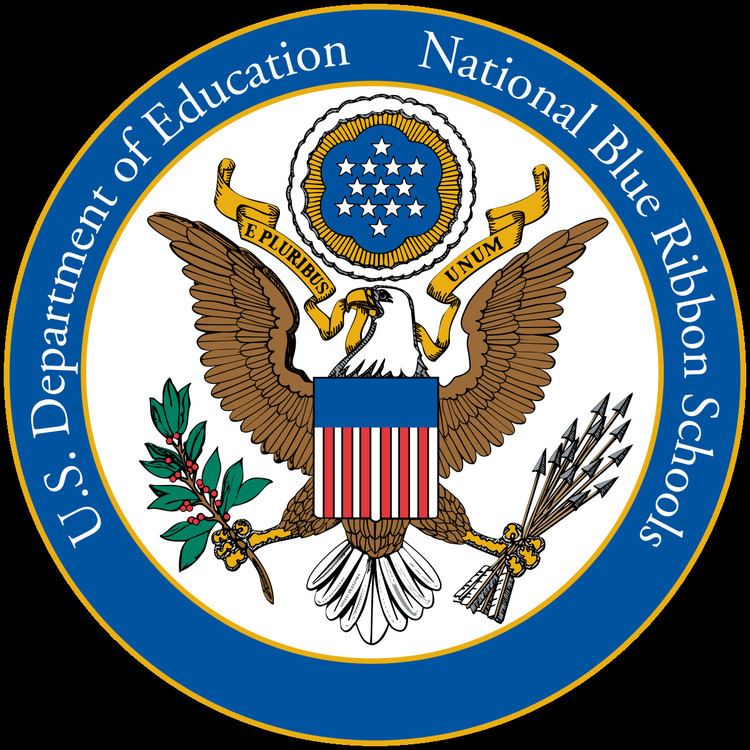 | ||
The National Blue Ribbon Schools Program is a United States government program created in 1982 to honor schools which have achieved high levels of performance or made significant improvements in closing the achievement gap among student subgroups. One-third of all schools nominated in any state must serve student populations of at least 40% from disadvantaged backgrounds.
Contents
More than 8,000 schools had been honored as Blue Ribbon Schools through 2020
.
History
In 1981, then-Secretary of Education Terrell H. Bell commissioned a study of American education. The report, issued two years later as A Nation at Risk, described a “rising tide” of mediocre schools that threatened the nation’s future.
Secretary Bell created the National Blue Ribbon Schools Award to bring exemplary U.S. schools to public attention and to recognize those schools whose students thrived and excelled. Working with the National Association of Elementary School Principals and the National Association of Secondary School Principals, Bell launched the National Blue Ribbon Schools and the National Distinguished Principals Programs. Both programs highlighted outstanding models of American schools and school leadership.
Initially, the National Blue Ribbon Schools program honored only secondary schools, and was later expanded to include primary schools. It was changed again to honor secondary schools and primary schools in alternate years and now honors secondary, middle, and primary schools each year. In 2003, the program was restructured to bring it in line with the No Child Left Behind Law, placing a stronger emphasis on state assessment data and requiring schools to demonstrate high academic success. Schools must show how data are interpreted and used and how curriculum, instruction, professional development and student support promote student success.
In 2012 it was renamed the National Blue Ribbon Schools program to distinguish it from a for-profit company which had appropriated the Blue Ribbon School name.
During its first 25 years of existence, the National Blue Ribbon Schools Award was granted approximately 5,600 times, recognizing 5,200 different schools. (Some schools have been selected two or more times.) More than 133,000 public, charter, private and parochial schools serving grades K-12 are eligible for the award. More than 8,000 schools had been honored as National Blue Ribbon Schools through 2016.
Schools that have been awarded five times include:
Schools that have been awarded four times include:
States, territories, the Bureau of Indian Affairs, and the Department of Defense Education Activity schools have joined the competition over the years. Special emphases have changed from year to year based on national priorities. School-wise, there is much diversity – both public and private schools have won the award, and specific education programs, such as Montessori education, have received the award as well.
Criteria
The National Blue Ribbon Schools Program accepts nominations of both public and private schools that meet one of two criteria:
• Exemplary High Performing Schools are among their state’s highest performing schools as measured by state assessments or nationally normed tests.
• Exemplary Achievement Gap-Closing Schools are among their state’s highest performing schools in closing achievement gaps between a school’s subgroups and all students over the past five years.
Eligible schools must have been in existence for five years and cannot have received the award within the five prior years.
Application procedure
Although at one time schools self-nominated for the award, this is no longer the case. At the invitation of the U.S. Secretary of Education, Chief State School Officers (including Washington, DC), the Department of Defense Education Activity, the Bureau of Indian Education, and the Council for American Private Education nominate eligible schools for the annual award. Eligible schools must demonstrate high or strongly improving student scores on state or nationally normed assessments in the last year tested; schools must also make Annual Yearly Progress in accordance with No Child Left Behind.
Nominated schools submit applications describing school operations such as the use of assessments and assessment data, curricula, professional development, leadership, and community and family involvement. A total of 417 schools may be nominated in any year; state quotas are determined by numbers of students and schools. The Blue Ribbon award is considered the highest honor an American school can achieve.
Criticism
David W. Kirkpatrick, the Senior Education Fellow at the US Freedom Foundation, noted in an editorial titled, "Awarding Blue Ribbons: Recognizing Schools or Students?" that criteria for the awards do not take into account the socioeconomic status of the students and that studies show that students who come from homes with higher income and better educated parents do better than students without these advantages by virtue of their backgrounds. Thus, the award is usually given to schools with students from wealthy backgrounds. As evidence to support his case, he pointed to the distribution of awards given in Pennsylvania one year; of eight schools receiving the award, only one was in a district whose income level was near the state average, and the rest went to districts with above average income, including two in the wealthiest community in the state.
Kirkpatrick proposed an alternative to recognizing "blue ribbon students"; he wrote, "Thus a more accurate indication of a good school would be one that adjusts for such socioeconomic factors and identifies those in which students do better than would normally be expected, based on their backgrounds."
From the program's inception through 2003, schools were permitted to nominate themselves. As of 2003 nominations are handled through a state liaison which schools must contact for nomination.
The program has also been criticized for assessment of schools coming from the school itself rather than an independent 3rd party and a nomination and assessment process that favors schools with the know-how and resources to complete the review assessment.
